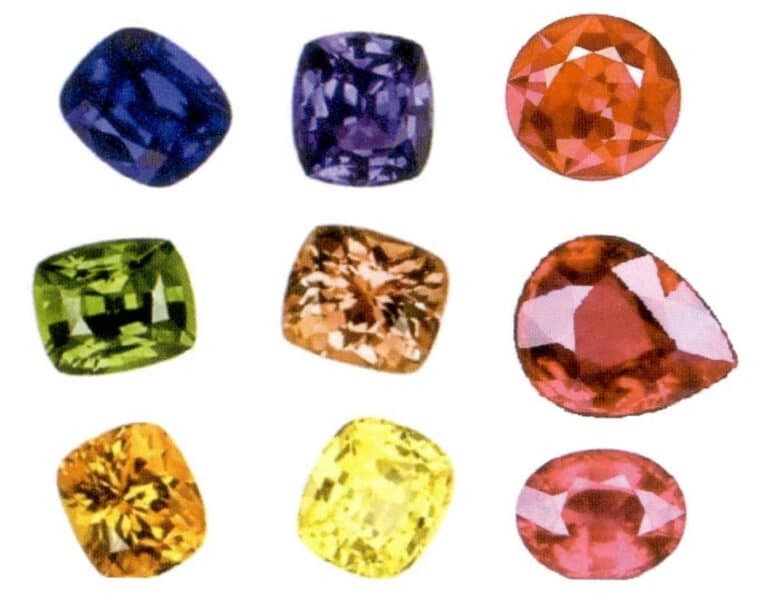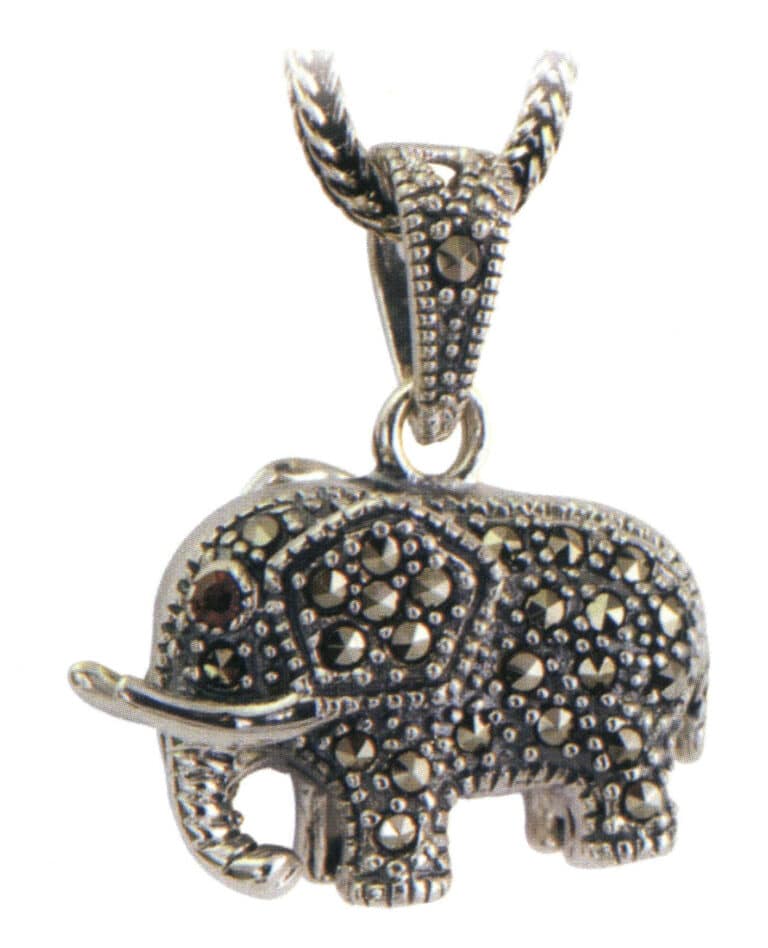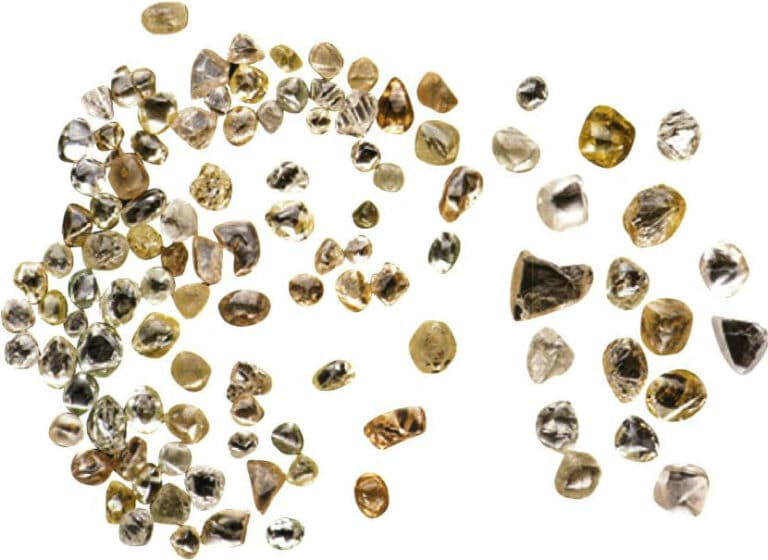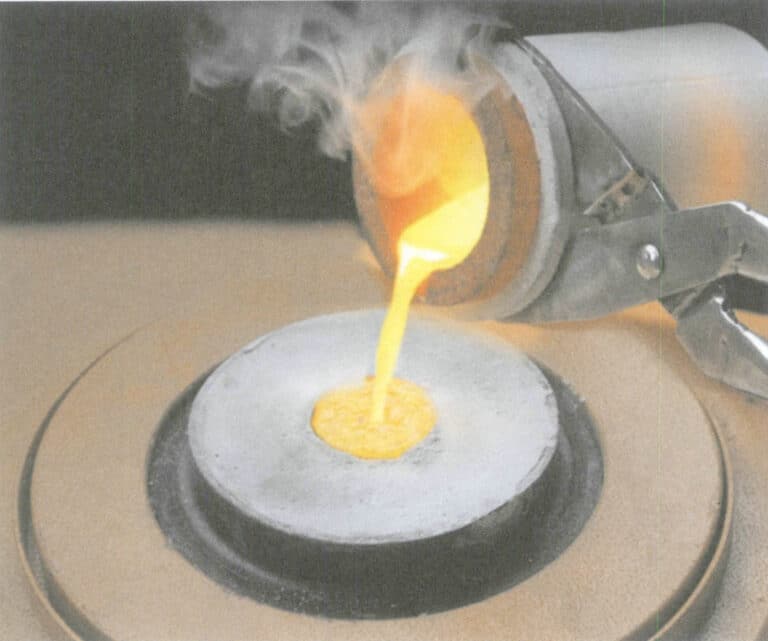Was ist Moissanit? Ein umfassender Leitfaden über Moissanit in Schmuckstücken
A Perfect Alternative Of Diamond
Einleitung:
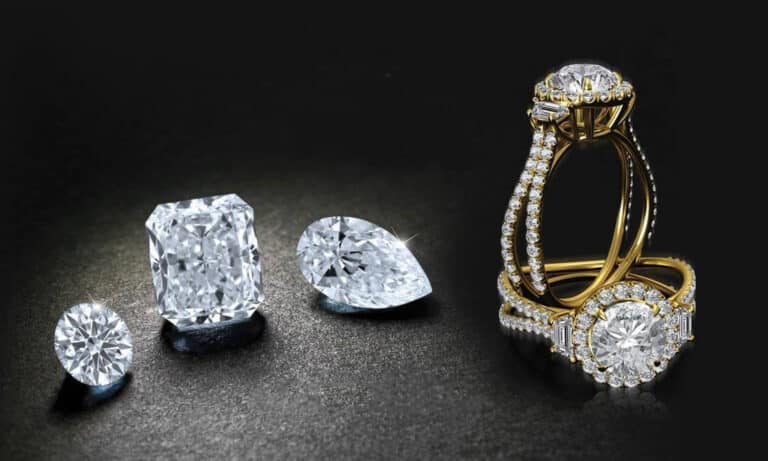
Lab grown moissanite jewelry
Inhaltsübersicht
Section I Understanding Moissanite
1. Definition of Moissanite
Moissanit is a gemstone made of silicon carbide (SiC), celebrated for its exceptional optical brilliance and durability. Although it’s often compared to diamonds due to visual similarities, moissanite is not a diamond simulant—it is its own unique gemstone with distinct scientific and gemological properties.
Discovered by Henri Moissan in 1893 in the remains of a meteorite crater in Canyon Diablo, Arizona, the mineral was so rare on Earth that natural occurrences are virtually nonexistent. Modern moissanite is therefore lab-grown, which provides remarkable consistency, quality control, and environmental sustainability. The lab-creation process uses high-temperature and high-pressure methods to form hexagonal silicon carbide crystals, a process that takes several weeks and requires extreme precision.
For the B2B jewelry industry, this means predictable supply, no reliance on mining, and reduced exposure to ethical concerns often associated with diamond sourcing. Sobling leverages these benefits by offering its partners direct access to certified lab-grown moissanite stones in a wide range of colors and cuts, all integrated into their customizable Eigenmarken-Schmuck und custom jewelry manufacturing programs.
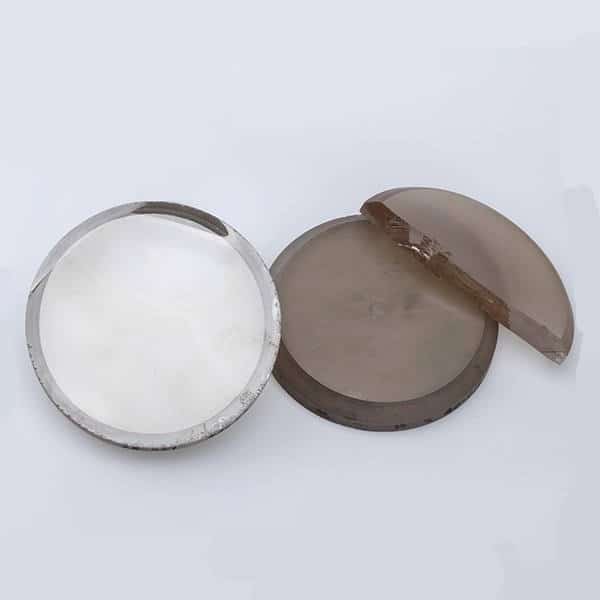
Moissanite Rough Materials
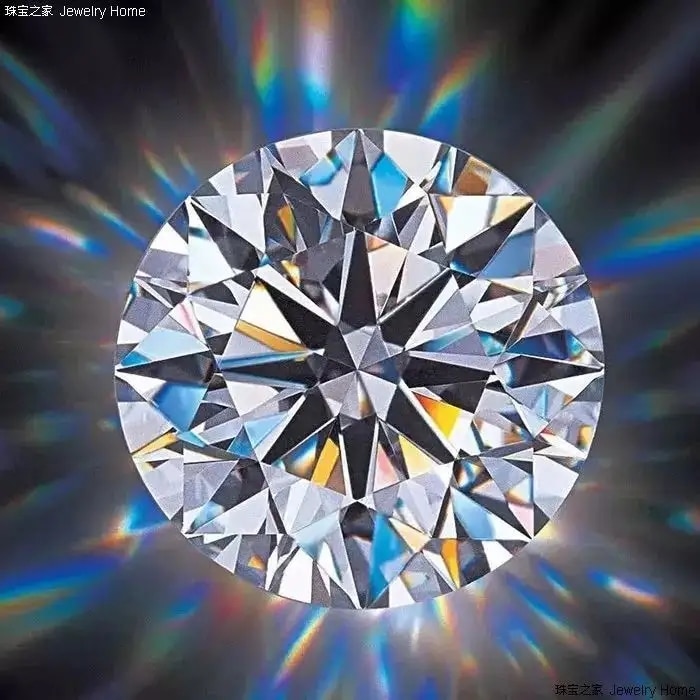
Moissanite Shinning Surface
2. Features
One of moissanite’s most talked-about attributes is its optical performance—particularly its brilliance and fire. Brilliance refers to the amount of white light reflected, while fire indicates the rainbow-like dispersion of light.
Moissanite scores a 2.65 to 2.69 on the Refractive Index (RI) scale, which is THE MOST BRILLIANT GEM ON THE EARTH. Its dispersion rating of 0.104 is nearly double that of a diamond’s 0.044, creating intense “rainbow fire” effects that many consumers find visually stunning.
Another critical feature is durability. On the Mohs hardness scale, moissanite ranks 9.25, second only to diamonds (10). This makes it highly resistant to scratches and abrasions—ideal for daily-wear pieces like engagement rings, stacking rings, or statement earrings.
Additional key features:
- Thermal Conductivity: Similar to diamonds, allowing it to pass most diamond testers.
- Chemical Stability: Does not fade or cloud over time.
- Environmental Impact: Requires significantly less energy and water than mined gems.
In the B2B Business, these properties translate into:
- Lower return rates
- Higher customer satisfaction
- Reduced cost per unit for brilliance
3. Gemological Value
While traditional gemstone valuation often emphasizes resale potential, moissanite redefines value from a design-first and story-driven perspective. It’s about accessibility, aesthetics, and meaning.
For manufacturers and private label brands, the most important moissanite value factors include:
- Stone size-to-cost ratio: A 1ct moissanite retails for 1% the cost of a diamond, allowing brands to offer “bigger looks” without compromising profitability.
- Visual parity: Under most conditions, the average consumer cannot visually distinguish high-grade moissanite from high-grade diamonds.
- Low inclusion risk: Thanks to precise lab controls, moissanite clarity levels are consistently VVS to IF.
Leading gem labs such as GRA, and IGI are providing grading certificates, particularly useful for engagement jewelry and upscale collections.
Table 1 Features of Moissanite
| Eigentum | Moissanit |
|---|---|
| Chemical Formula | SiC (Silicon Carbide) |
| Crystal Structure | Hexagonal |
| Mohs Hardness | 9.25 |
| Brechungsindex | 2.65–2.69 |
| Dispersion (Feuer) | 0.104 |
| Lüster | Adamantine to Metallic |
| Transparenz | Transparent |
| Color (Lab-Grown) | Colorless to Fancy Colors |
Section II Moissanite Used in Jewelry
1. Natural moissanite vs. lab-grown moissanite?
Shocked to learn moissanite is mostly man-made? You’re not alone.
Natural moissanite is extremely rare, while nearly all moissanite used in jewelry today is lab-grown for consistency, availability, and ethical reasons.
Let’s be real: you’re probably never going to see a natural moissanite in a jewelry store. Not because it’s undesirable—because it’s almost impossible to find.
Natural moissanite comes from space. The first known crystals were discovered in meteorites. Since then, tiny traces have been found in volcanic rock, upper mantle inclusions, and diamond mines, but they’re microscopic and too small to be used in any meaningful way for jewelry.

Lab-Grown Moissanite: The Real Star
The moissanite we see today in rings, earrings, and necklaces is lab-grown. And that’s not a compromise—it’s a game-changer.
Lab-grown moissanite is created using high-temperature processes that replicate the crystal formation of natural silicon carbide. These methods—pioneered in the 1990s—allow manufacturers to produce high-quality stones in larger sizes, with better clarity, and at scale.
Here’s how they compare:
Table 2 Natural moissanite vs. lab-grown moissanite
| Eigentum | Natural Moissanite | Lab-Grown Moissanite |
|---|---|---|
| Origin | Meteorites or rare geological sources | Laboratory synthesis |
| Availability | Extremely rare | Readily available |
| Größe | Tiny crystals | Up to 10+ carats |
| Purity & Clarity | Often imperfect | Highly controlled and consistent |
| Jewelry Use | Not practical | Ideal for all kinds of jewelry |
| Ethical & Eco-friendly | N/A | Yes — no mining required |
Why Lab-Grown Is Preferred
Lab-created moissanite offers consistent quality, ethical sourcing, and a much lower price point than diamonds. For brands like ZENMOISSANITE, that means creating stunning silver jewelry that’s affordable, sustainable, and dazzling—without compromising ethics or performance.
Video 1: From Raw Material to Shimmering Diamonds, How To Do Moissanite Cut? Step by step Guide — Sobling
2. Difference Between Moissanite and Diamond
Though moissanite and diamond are visually similar, especially to the untrained eye, their composition, performance, and market role are quite distinct. Understanding these differences is essential for B2B buyers who need to educate end consumers, manage expectations, and differentiate SKUs across multiple price points.
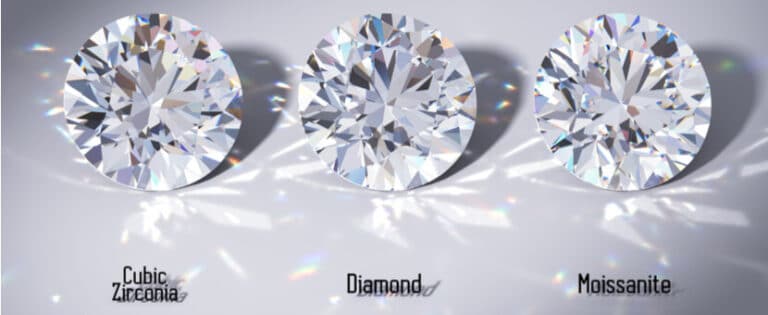
2.1 Optical Characteristics
2.2 Durability
2.3 Pricing
2.4 Ethics and Sustainability
3. Difference Between Moissanite and Zircon
Zircon is a natural zirconium silicate (ZrSiO₄) gemstone.
Cubic zirconia (CZ) is often mistaken for moissanite in the mass market, but the differences are stark. While both are lab-created, only moissanite is suitable for high-end or engagement jewelry, that can pass the test of diamond tester.
CZ dulls quickly, especially when exposed to oils, perfumes, or detergents. Moissanite retains its brilliance for life and is often offered with a lifetime clarity guarantee, something impossible for CZ vendors.
Table 3 Diamond VS Moissanite VS Cubic zirconia
| Feature | Diamant | Moissanit | Kubische Zirkoniumdioxid (CZ) | Explain |
|---|---|---|---|---|
| Chemical Formula | Kohlenstoff (C) | Silicon Carbide (SiC) | Zircon(ZrSiO4) | |
| Crystal Structure | Cubic | Hexagonal | Tetragonal | Moissanite’s hexagonal structure gives it double refraction, increasing brilliance |
| Härte (Mohs) | 10.0 | 9.25 | 8–8.5 | Moissanite is as same Durability and hardness as diamond |
| Refractive Index (Brilliant) | 2.42 | 2.65–2.69 | 1.81–2.00 | Moissanite has Higher brilliance than diamond |
| Dichte | 3.52 g/cm³ | 3.22 g/cm³ | 4.6---4.7 g/cm³ | Moissanite is the most similar to diamonds |
| Fire (Dispersion) | 0.044 | 0.104 | 0.039 | Moissanite has 2.5x more rainbow flashes (fire) than diamonds |
| Longevity | Lifetime | Lifetime | Prone to dulling | No worries to lose clusters of moissanite |
| Klarheit | Random | Super Clear, Top grade D | Milky/cloudy | Moissanite go up to D color for each piece |
| Perceived Value | Geuine Gems | High-end substitute | Low Value/fashion only | Perfect Substitute for diamonds |
| Thermal Resistance | <800°C (oxidizes in air) | Up to 2000°C | 500–600°C (prone to cracking) | Moissanite can withstand extreme temperatures. Compatible to wax setting technology of jewelry makings |
| Price per Carat | About $2000 | $5-15 | $0.5 | Lower Cost loved |
| Pass diamond tester | OK | OK | FAIL | Only moissanite can do expect diamonds |
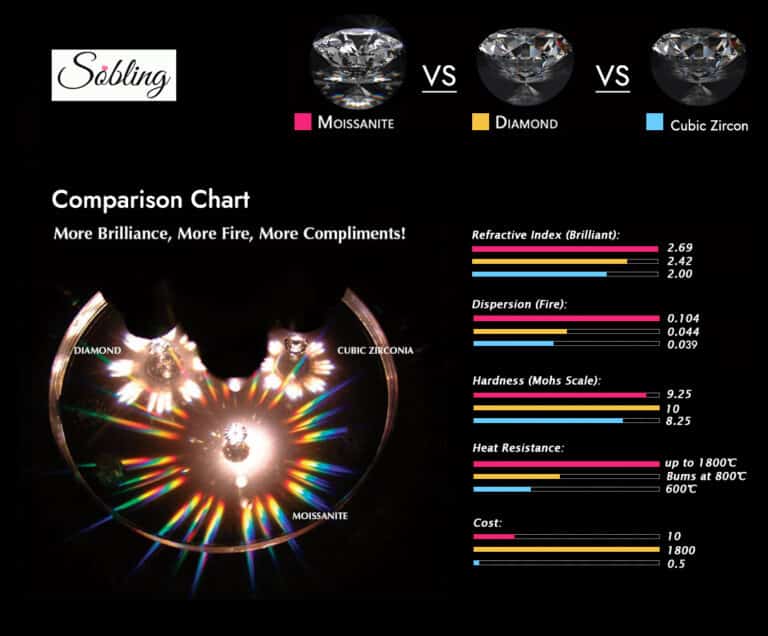
4. Moissanite Appraisal and certifications
4.1 Appraisal Standard and certificates
Same like diamonds, Moissanite can be appraised according to the 4Cs system (cut, clarity, color, and carat) defined by GIA, while moissanite does not yet have a globally standardized grading body.
The primary factors used to evaluate moissanite include color, clarity, cut, carat weight, and optical performance.
| Grading Factor | What It Measures | Impact on Value |
|---|---|---|
| Farbe | Whiteness of the stone (D–K scale) | Colorless (D–F) = Higher value |
| Klarheit | Presence of inclusions or blemishes | Flawless = Premium quality |
| Schnitt | Precision and symmetry of facets | Ideal cut = Maximum brilliance |
| Carat Weight | Size of the moissanite | Larger = Higher price |
| Brilliance & Fire | Light reflection and rainbow dispersion | Higher = More desirable |
💡 High-quality moissanite can closely mimic the best diamonds in color and clarity, making grading an essential part of the buying process.
However, multiple reputable labs now offer moissanite-specific certifications, such as:
- GRA (Gemological Research Association)
- IGI (International Gemological Institute) (for select stones)
A GRA (Gemological Research Association) Certificate contains:
- Laser-Engraved Serial Number – Matches the physical stone to the certificate.
- Grading Report – Details on carat weight, color, clarity, and cut.
- Proportions Chart – Breakdown of the stone’s facet angles and symmetry.
- Clarity Characteristics – Indicates if the stone has any inclusions.
- Color Grading (D–K Scale) – Shows if the stone is colorless or slightly tinted.
💡 Each certified moissanite stone has a unique laser-engraved number, visible under magnification, ensuring authenticity and traceability.
Certification matters greatly in B2B sales—especially when targeting bridal or premium buyers. For emerging brands, providing certification helps build trust, reduce returns, and increase perceived value.
4.2 How is Moissanite Tested?
Authenticity matters—especially in the jewelry industry.
Moissanite certification ensures each stone meets quality standards, while advanced testing tools confirm its identity, boosting consumer confidence.
Whether you’re a jewelry brand, retailer, or buyer, understanding how moissanite is tested and certified guarantees trust in your purchases.
Test tools and equipment?
Not every sparkle is a diamond—but how can you tell?
Moissanite is tested using advanced gemological tools like diamond testers, X-ray fluorescence machines, and spectrometers to verify its identity.
① Diamond Tester (Thermal Conductivity & Electrical Conductivity)

-
- Moissanite and diamonds conduct heat similarly, so thermal diamond testers often mistake moissanite for diamond.
- However, electrical conductivity testers can differentiate moissanite, as moissanite conducts electricity while diamonds do not.
💡 Some moissanite stones test positive as diamonds using standard testers, requiring advanced verification tools.
Video 2: Assher halo Moissanite stud earring PASS the dimond tester — Sobling
② X-Ray Fluorescence (XRF) Spectroscopy
- Used in labs to detect the chemical composition of moissanite (Silicon Carbide – SiC).
- This method is foolproof for separating moissanite from cubic zirconia (CZ) and diamonds.
③ UV-VIS-NIR Spectrophotometer
- Determines the absorption spectrum of moissanite, distinguishing it from other gemstones.
- Essential for high-end certification processes.
💡 For jewelers, using both thermal and electrical conductivity tests ensures 100% accurate moissanite identification.
5. Moissanite Quality Factors
5.1 Moissanite Cut and Shape
Cut determines the stone’s brilliance, fire, and appeal. Moissanite is available in all the popular cuts used for diamonds, including:
- Round Brilliant – Most common and highest in fire.
- Cushion – A vintage-favorite, soft-edge shape.
- Oval – Elegant, elongating on fingers.
- Pear – Modern and eye-catching.
- Emerald (Step Cut) – Understated brilliance, very popular in minimalist bridal jewelry.
- Radiant & Asscher – For a bold, geometric look.

Moissanit Form Tabelle
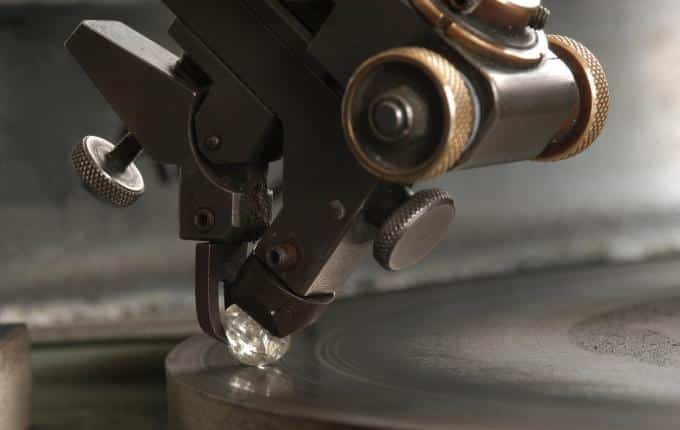
Moissanite Polished
| Cut Type | Effect on Sparkle | Market Demand |
|---|---|---|
| Ideal Cut | Maximum brilliance, fire | Most valuable |
| Excellent Cut | High sparkle, precise facets | Standard high-quality |
| Good Cut | Some brilliance loss | Budget-friendly |
| Poor Cut | Dull, uneven light return | Least desirable |
💡 An “Ideal Cut” moissanite outshines even the best diamonds in fire and brilliance.
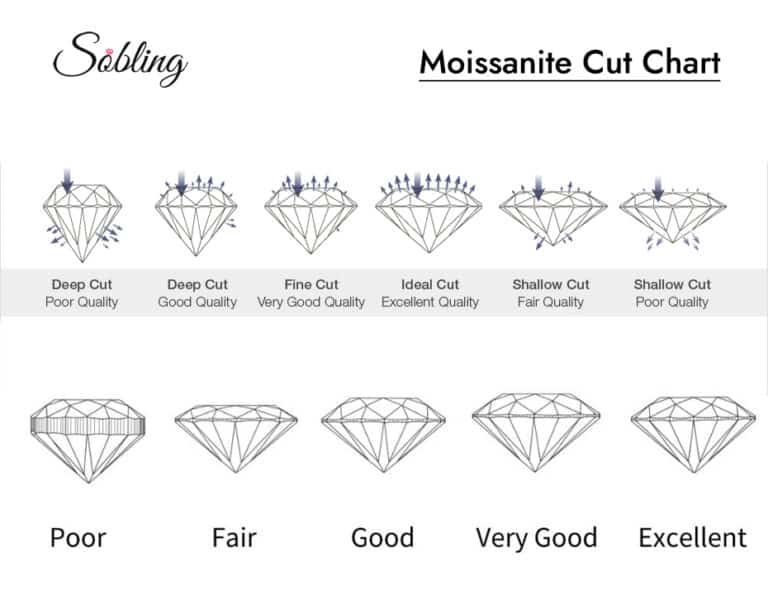
Moissanite 4C appraisal system cut grade
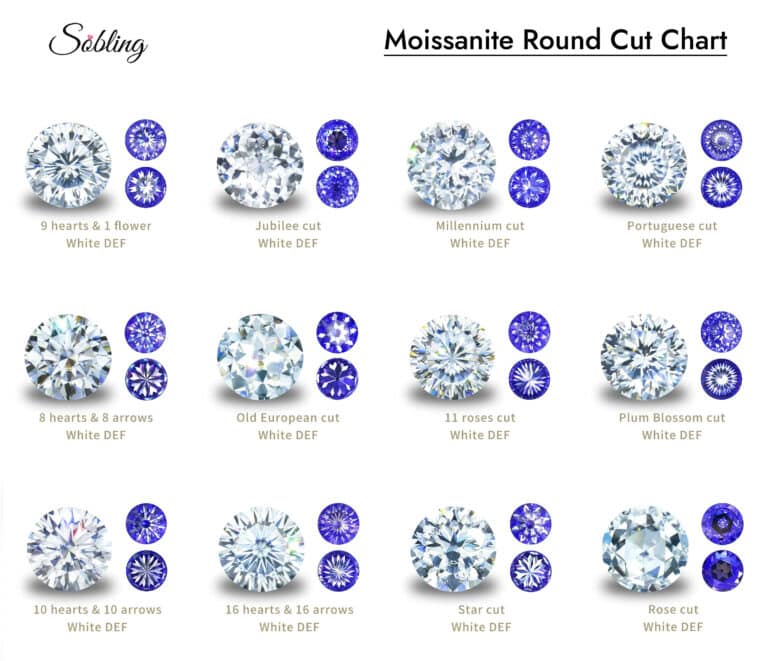
Moissaniet Round Cut
Video 4: Various Fancy Moissanite moissanite Diamond Cut -Sobling
5.2 Moissanite Color Grade
| Klasse | Tone | Market Usage | Value |
|---|---|---|---|
| D–F | Farblos | High-end bridal collections | Pure white, highest value |
| G–H | Slightly warm | Minimalist rings, daily-wear pendants | Middle quality, fashion value |
| I–K | Faint Color | Vintage-style or lower-price point lines | Yellowish or grayish tint, lower value |
| Colorful | Champagne, Blue, Pink, Green | Trend-driven, Gen Z targeted collections | Rainbow colors, multi colorful world |
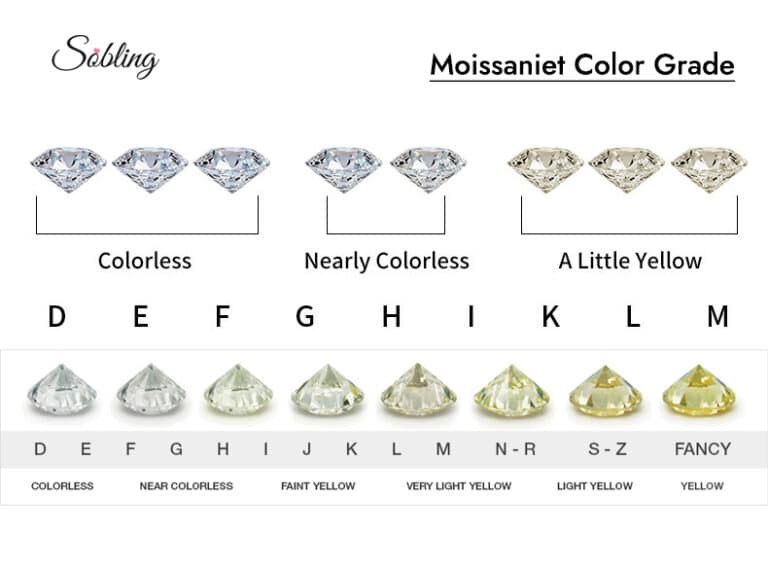
| Tier | Typical Color Grade | Target Market |
|---|---|---|
| Premium / Elite | D–F | Luxury bridal, fine jewelry |
| Standard | G–H | Mid-range silver jewelry |
| Budget / Fashion | I–K or below | Entry-level fashion accessories |
Moissanite colorful range from pure white to rich, vivid hues, they come in:
- White – Classic diamond-like brilliance
- Yellowish / Yellow / Vivid Yellow – Warm golden hues for vintage-inspired styles
- Golden – A deep, amber-like gold tone
- Pink – Feminine, romantic, and on-trend
- Grey – Subtle, sophisticated, and modern
- Pale Green / Green / Dark Green – Earthy and nature-inspired tones
- Cyan / Blue / Dark Blue – Cool, oceanic hues with a bold appeal
- Black – Sleek and mysterious, perfect for contemporary designs
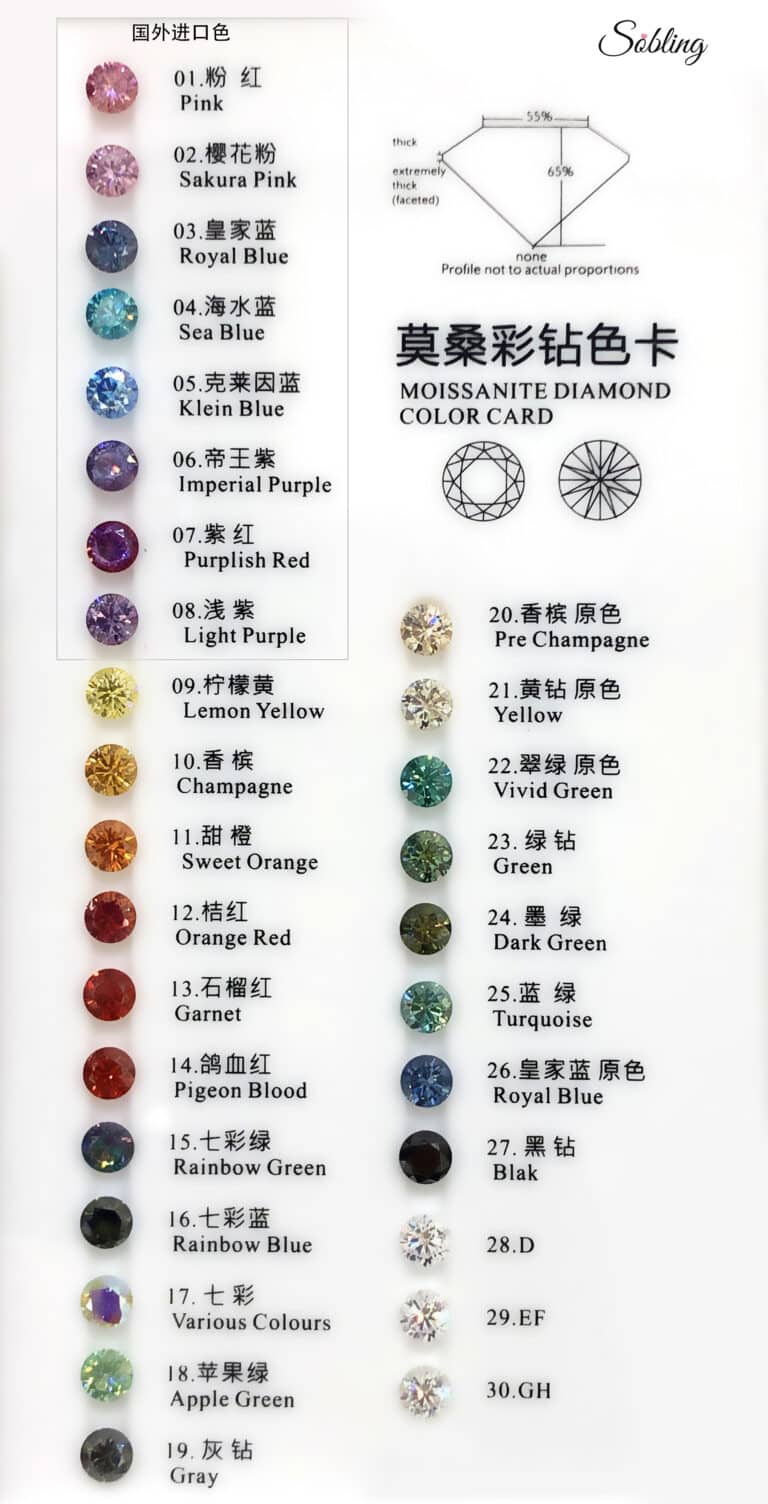
Color changes everything—from sparkle to personality.
The color of moissanite influences its brilliance, fire, and overall aesthetic, making each shade suited for different jewelry styles.
| Farbe | Appearance & Sparkle | Best Use |
|---|---|---|
| Weiß | Brightest sparkle, classic diamond-like look | Engagement rings, luxury jewelry |
| Yellow / Gold | Warm glow, vintage and antique feel | Retro, vintage, and Art Deco designs |
| Rosa | Soft, romantic, and trendy | Wedding rings, feminine fashion |
| Grün | Unique, fresh, and earthy | Nature-inspired and statement jewelry |
| Blau | Deep brilliance, bold aesthetic | High-fashion pieces, modern engagement rings |
| Schwarz | Minimalist, sleek, and elegant | Men's jewelry, gothic and edgy styles |
5.3 Moissanite Clarity
| Reinheitsgrad | Beschreibung | Value Impact |
|---|---|---|
| FL–IF | Flawless/Internally Flawless | Highest value |
| VVS | Very, very slightly included | Premium quality |
| VS | Very slightly included | Moderate value |
| SI | Slightly included, may be visible under 10x | Lower value |
💡 Most high-quality moissanite is FL–VVS, ensuring an eye-clean appearance.
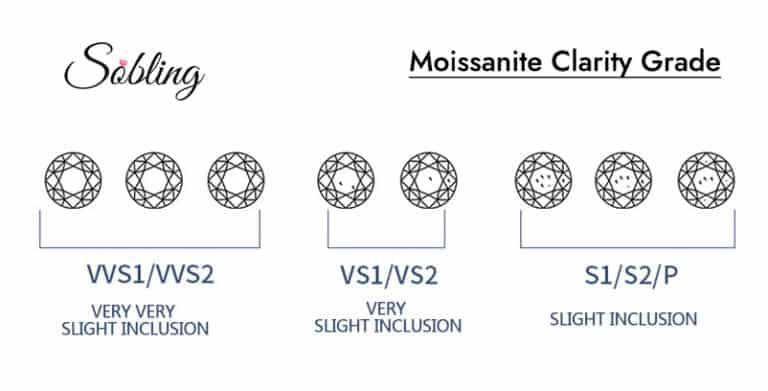
5.4 Moissanite Carat weight to size chart


6. Moissanite Certification and Certificate
Certification is more than paperwork—it’s part of your product story and marketing experience. For retailers, having a certificate:
- Reduces customer hesitation
- Increases social proof
- Provides legal protection on returns or exchanges
- Supports higher price justification
Examples of Moissanite Certificates.

Real Use Case: U.S. DTC Bridal Brand
“Adding GRA certification to our moissanite engagement line increased our conversion rate by 12% within the first quarter. Consumers started treating it as a lifetime ring, not a costume alternative.”
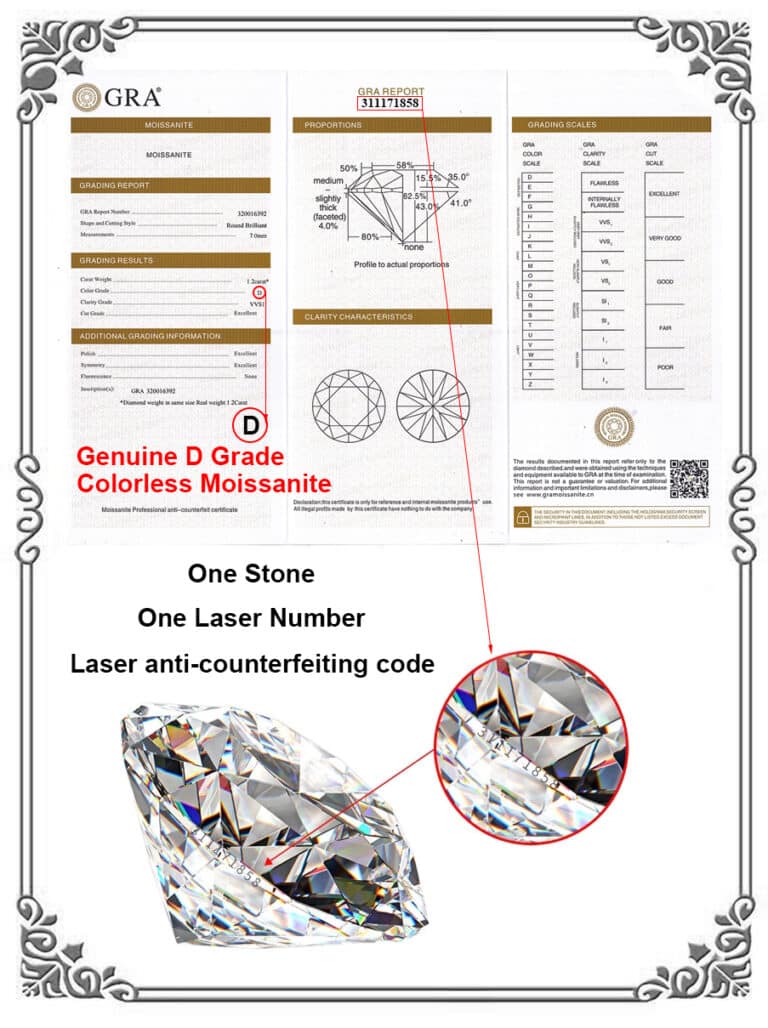
Moissanite gra certificate 1
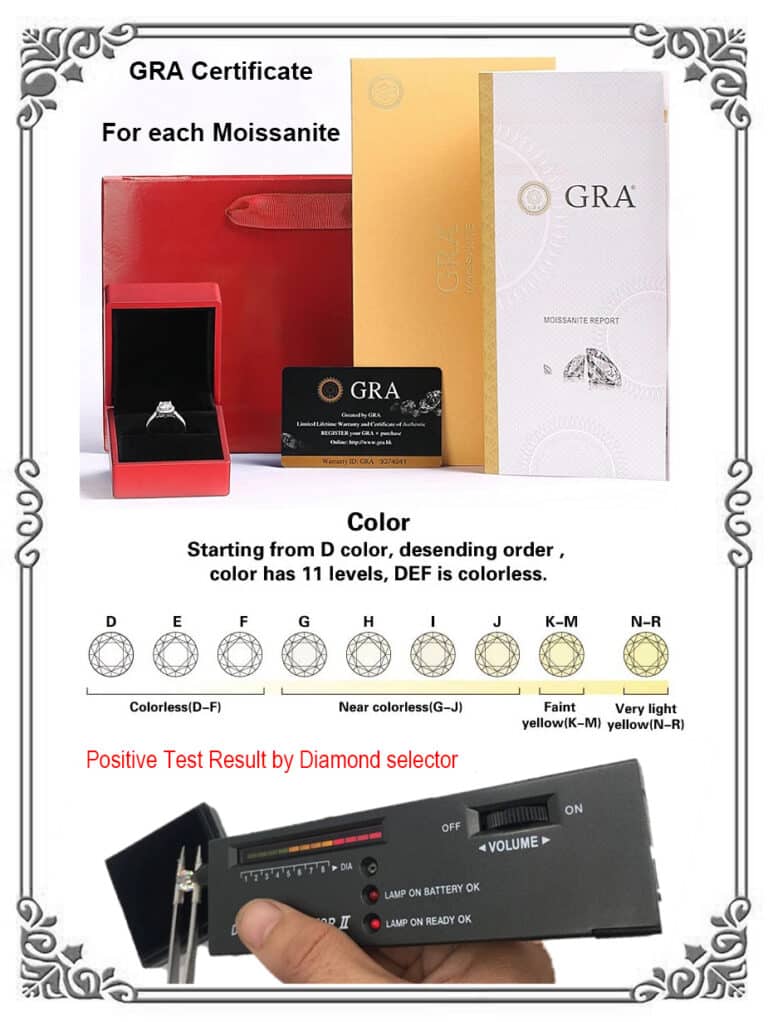
Moissanite gra certificate 2
What’s your benefits to choose Moissanite
| Feature | Value to B2B Retailers |
|---|---|
| Diamond Comparison | Nearly same as the diamonds, able to pass diamond tester, but only 1% cost |
| Zircon Comparison | Strong quality perception and repeat purchase |
| Appraisal System | Same appraisal as genuine diamonds, ensure high quality and nice feedback from customers |
| Certificates available | Win customer’s trust and repeated orders |
Moissanite is no longer positioned as a diamond “substitute”—it is a category-defining product. For jewelry brands and suppliers, it offers a new frontier in product development, storytelling, and profitability.
With the right manufacturer, moissanite jewelry can help your business scale collections with lower risk and higher emotional engagement. In Part 3, we will explore how global market trends and consumer psychology are fueling moissanite’s rise to prominence.
Section III The Popularity and Market Potential of Moissanite Jewelry
1. Reasons for Moissanite’s Popularity

1.1 Aesthetic Appeal Meets Affordability
Consumers are drawn to moissanite primarily for its unmatched sparkle and competitive price point. Unlike cubic zirconia, which is often perceived as “fake,” moissanite offers premium visual appeal while maintaining a level of authenticity as a distinct, lab-created gem.
Many customers now ask: “Why would I spend $8,000 on a 1.5ct diamond when I can get a 2ct moissanite with better fire and clarity for $7?” This mindset shift has created new emotional and financial justification for choosing moissanite, especially in bridal and self-purchase categories.
Here’s a pricing breakdown (approximate):
| Stone Type | 1 Carat Price Range | Durability | Visual Appeal |
|---|---|---|---|
| Diamant | >$2,000 (natural) | 10 (Mohs) | High brilliance, status symbol |
| Moissanit | $5–15 | 9.25 | More fire than diamond |
| Kubischer Zirkoniumdioxid | $0.5 | 8.0–8.5 | Bright, but dulls over time |
| Lab Diamond | $50---250 | 10 | Real diamond, ethical origin |
| White Sapphire | $200–$350 | 9.0 | Less brilliance, more subtle |
Moissanite strikes the balance—more sparkle than sapphire or CZ, much more affordable than a diamond, and more durable than most alternatives.
💡 This makes moissanite ideal for brands offering affordable luxury, sustainable engagement rings, or customizable fashion pieces.
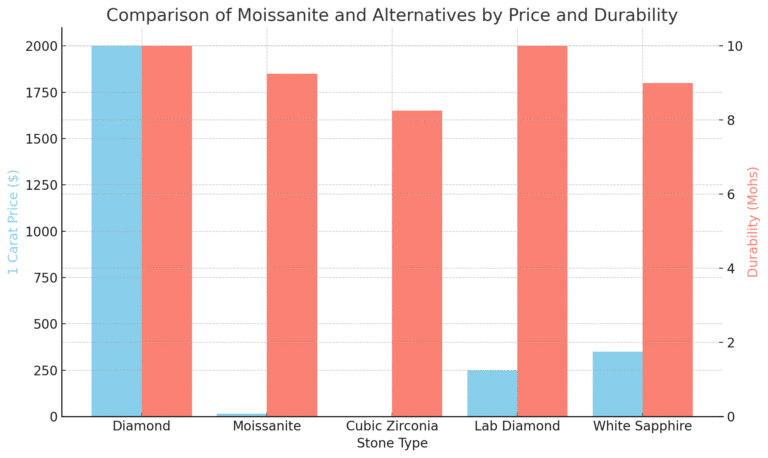
Copywrite @ Sobling.Jewelry - Hersteller von kundenspezifischem Schmuck, OEM- und ODM-Schmuckfabrik
1.2 Ethics-First Consumers
In a post-COVID, value-driven landscape, consumers increasingly prioritize products that align with their ethics. Moissanite checks all the right boxes:
- Lab-created (no mining)
- Conflict-free
- Environmentally low-impact, Low carbon footprint
- Fully traceable
This makes it especially attractive to Millennial and Gen Z buyers, who now account for over 60% of online fine jewelry sales globally.
A 2023 survey by The Jewelry Consumer Council found that 74% of Gen Z jewelry buyers “prefer lab-grown gems for ethical and environmental reasons.”

1.3 Social Media Influence
The rise of TikTok, Instagram Reels, and YouTube Shorts has accelerated the visibility of moissanite. Influencers like @moissiegirl and @stoneoverdiamonds have amassed millions of views by showcasing “diamond dupes” and “ethical sparkle.”
The short-form video format works perfectly for moissanite:
- Quick A/B comparisons
- Close-up sparkle videos
- Behind-the-scenes: “What’s in the box” reveals
- Reactions: “Told them it’s a diamond—watch what happens”
2. Market Potential of Moissanite Jewelry
2.1 Global Demand Forecast
According to data from OpenPR and Statista, the global moissanite market is expected to reach $7.8 billion by 2027, growing at a CAGR of 8.4%. The strongest growth is expected in:
- North America (particularly U.S. and Canada)
- Western Europe (UK, Germany, France)
- Southeast Asia (Singapore, Thailand, Vietnam)
- The Middle East (UAE, Saudi Arabia, Turkey)
“Moissanite is no longer a ‘budget choice.’ In 2025, it’s a branding opportunity.”
— GemVision Global Market Outlook 2024
These regions show high receptivity to:
- Sustainable product claims
- Customization (wedding, stacking sets, symbolic pieces)
- DTC buying habits (especially via mobile)
| Glanzgrad | Qualitätsanforderungen | |
|---|---|---|
| Chinesisch Beschreibung | Englischer Code | Qualitätsanforderungen |
| Äußerst stark | H2O H2O | Das reflektierte Licht ist hell, scharf und gleichmäßig, und das Bild ist sehr klar. |
| stark | B | Das reflektierte Licht ist hell, und die Oberfläche kann das Bild des Objekts sehen. |
| Mittel | C | Das reflektierte Licht ist nicht hell, die Oberfläche kann das Objekt reflektieren, aber das Bild ist relativ unscharf. |
| Schwach | D | Das reflektierte Licht ist diffus; die Oberfläche hat einen matten Glanz und fast keine Reflexion. |
| Hinweis: Der Glanzgrad von Süßwasserperlen in Edelsteinqualität ist mindestens mittel (C). | ||

2.2 B2B Segment Growth
| B2B Segment | Moissanite Opportunity |
|---|---|
| Private Label Brands | Low-MOQ, white-label ready designs |
| Regional Retailers | High-margin collections with fast restock cycles |
| Wedding Boutiques | Ethical engagement ring lines with story-first appeal |
| Fashion Jewelry Lines | Trend-responsive drop-style releases |
| Online Marketplaces | Custom request fulfillment (Etsy, Shopify, Woo) |
3. The TikTok Effect on Moissanite
One of the most remarkable trends has been the role of short-form video in “normalizing” moissanite as a premium choice.
Common themes among viral videos:
- “Is it real or not?” — comparison videos
- “Why I ditched diamonds” — ethics-driven storytelling
- “Under $1000, under $500” — value-centric pitches
- “This looks like $10k” — aspirational framing
This visual virality, especially among Gen Z, positions moissanite not as an imitation, but as a smart, status-savvy purchase. Brands that align themselves with this messaging can gain quick traction—particularly if they:
- Use storytelling in product names (e.g. “Celestial Spark”, “Meteor Ring”)
- Emphasize “lab-created brilliance” vs “fake diamond”
- Offer styling guides and pairing ideas (e.g. “3 ways to stack your sparkle”)
4. Pricing and Margin Potential
| Material | Avg. Wholesale Cost | Retail Value (Branded) | Typical Markup |
|---|---|---|---|
| Diamond (1ct) | $2000+ | $5000–$9000 | 1.2–2.0x |
| Moissanite (1ct) | $5–15 | $12–$30 | 2.4–6.0x |
| CZ (1ct) | <$0.5 | $0.75–$1.5 | 1.5–3.0x |
This pricing structure allows brands to:
- Launch luxury-style collections for Gen Z consumers
- Expand from “entry-level silver” to “affordable fine”
- Offer flexible payment options or subscriptions
At Sobling, our partners report that moissanite-based designs outperform traditional CZ designs by 3–5x in lifetime value and 20% faster turnover rate.
5. Long-Term Trends to Watch
(1) Increasing lab-grown acceptance across luxury brands
Even legacy brands like Pandora and Brilliant Earth are expanding lab-grown lines, giving moissanite indirect brand endorsement.
(2) Rise of male and unisex moissanite jewelry
Moissanite is no longer confined to rings. Bracelets, pendants, and unisex Cuban link chains with moissanite pave are seeing rising demand—especially in hip-hop and urban fashion.
(3) Customized experience and co-creation
DTC brands are using moissanite as a core material for online ring builders, AR try-on tools, and story-led marketing campaigns.
(4) Investment potential?
Can moissanite hold or increase its value over time?
Moissanite is not considered a financial investment like diamonds, but its resale value is improving as demand and awareness grow.
Let’s be clear: moissanite doesn’t carry intrinsic value like a natural diamond or rare colored gem. However, that doesn’t mean it’s worthless. Instead, it offers “emotional ROI”—a stunning appearance, ethical peace of mind, and long-lasting wearability at a lower entry price.
Factors that limit investment potential:
- It’s lab-created and reproducible.
- It lacks the rarity premium that diamonds or rubies command.
- Resale markets are still growing and less standardized.
Factors that support future value:
- Consumer shift toward ethical and affordable alternatives
- Sustainability-conscious younger buyers
- Social media and influencers increasing awareness
- Technological advancements driving product quality
Growing resale interest
While resale prices are generally 50–80% of retail value, the pre-owned moissanite market is expanding. Platforms like Facebook Marketplace, eBay, and sustainable bridal marketplaces are beginning to normalize moissanite resale.
For jewelry brands, this means moissanite products now offer:
- Strong upfront margins
- Emotional selling points (sparkle + ethics)
- Lower risk of stock devaluation
Summary for B2B Brands
Moissanite jewelry isn’t just a trend—it’s a strategic shift in how consumers perceive sparkle, status, and sustainability. For B2B buyers, this gemstone unlocks a high-velocity, high-margin, and low-risk growth channel.
If you’re ready to ride the wave of ethical elegance and scalable customization, moissanite is the gem of the moment—and Sobling is your partner for making it shine.
Section IV Suitability and Precautions for Moissanite Jewelry
1. Suitable People to Wear Moissanite Jewelry
1.1 Engagement and Bridal Customers
This is perhaps the most prominent buyer group. Moissanite has become an increasingly common center stone in modern engagement rings, particularly among young couples looking for:
- Affordability without visual compromise
- A meaningful ethical choice
- Larger carat sizes within budget
- Unique or vintage-inspired ring designs
Many buyers explicitly search for “non-diamond engagement rings” or “lab-grown bridal sets.” B2B brands can craft messaging like:
“Real love. Real sparkle. Ethically created.”
Sobling offers full bridal suites—engagement rings, wedding bands, eternity styles—with coordinated moissanite sets to help our partners sell across lifecycle events.
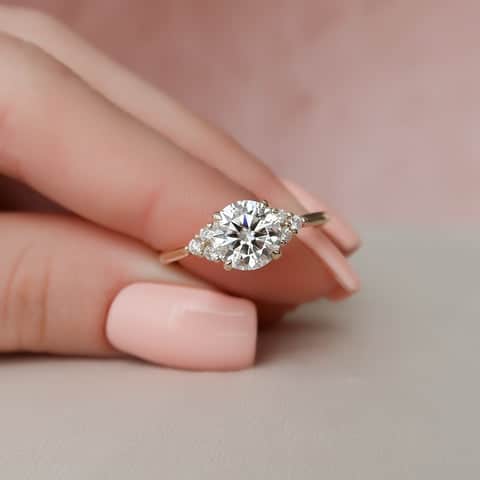
1.2 Working Professionals and Self-Gifts
With the rise of female empowerment and self-purchase, many working women (age 25–45) now seek elegant daily-wear jewelry with luxury finishes. Moissanite offers:
- Low maintenance
- Hypoallergenic settings
- Confidence-boosting sparkle at accessible prices
These customers aren’t just choosing jewelry—they’re choosing status without the story of debt. Offering sleek moissanite solitaire pendants, minimalist earrings, and stackable rings allows brands to target this powerful buyer persona.
1.3 Gift Givers and Occasional Buyers
Moissanite also appeals to gift-oriented buyers looking for meaningful presents that feel special but don’t require a huge budget. This includes:
- Anniversary gifts
- Mother’s Day
- Graduation gifts
- Valentine’s / Holiday campaigns
With custom engraving, birthstone accents, and personalized packaging, moissanite gift lines can generate repeat seasonal revenue and drive word-of-mouth.
🎀 Sobling supports:
- Drop-shipping solutions
- Custom gift messages
- Occasion-specific designs

1.4 Ethical and Eco-Conscious Consumers
Environmental awareness isn’t a niche—it’s the new standard. According to McKinsey’s 2023 Luxury Outlook, over 62% of global luxury consumers now prefer brands with transparent environmental impact statements.
For these buyers, Sobling’s lab-created moissanite + recycled silver combinations are ideal. We provide certificates of sustainability, factory audit sheets, and visual content for storytelling.
💡Marketing Tip: Pair moissanite with content like “From lab to love” or “Zero mining. 100% beauty.”
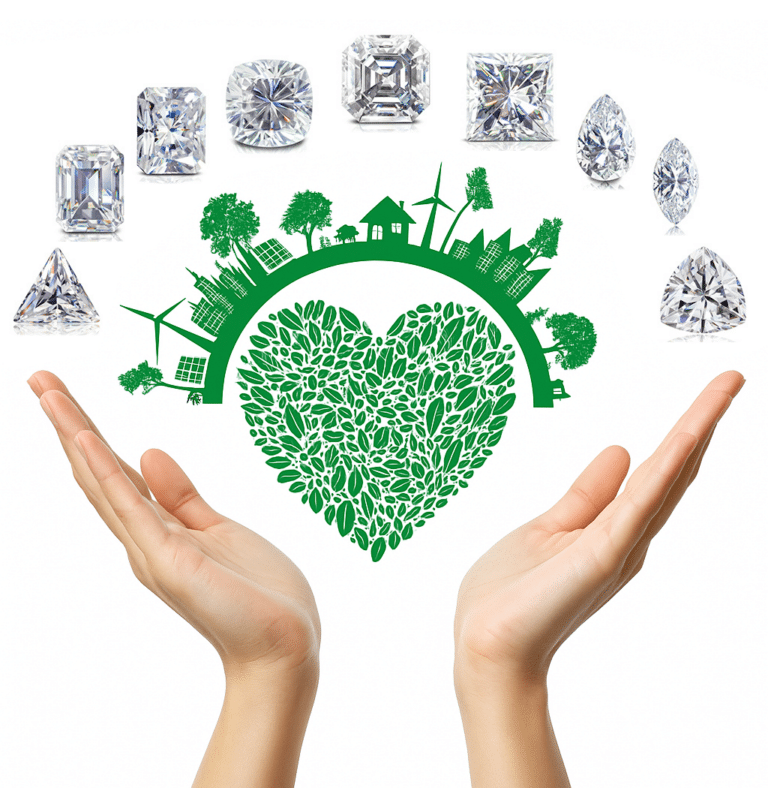
2. Precautions for the Care and Maintenance of Moissanite Jewelry
Though moissanite is tough and resilient, educating your customers on proper care practices:
- Increases product lifetime value
- Reduces customer complaints
- Lowers return/refund rates
- Enhances brand reputation
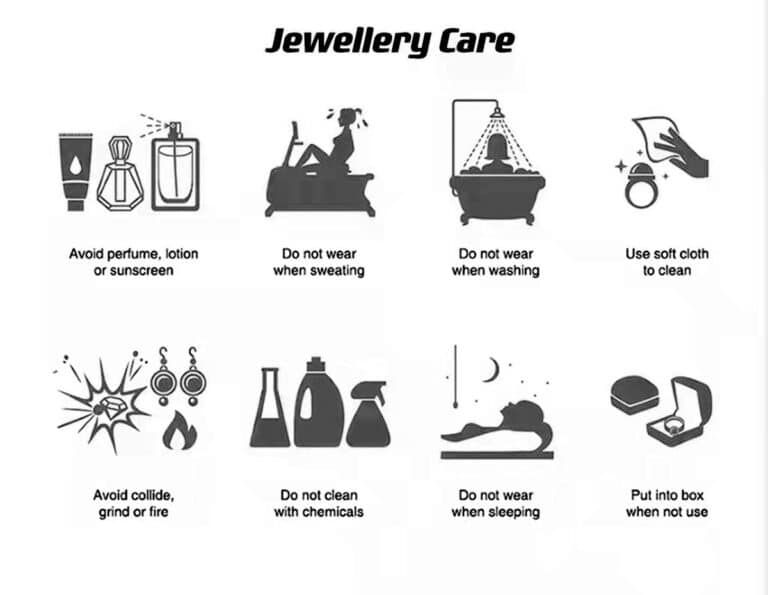
2.1 Daily Cleaning
Moissanite retains brilliance better than most gemstones, but residue from skin oil, lotion, and water minerals can reduce shine.
Recommended:
- Warm water + gentle dish soap
- Soft-bristled brush
- Dry with lint-free cloth
Avoid:
- Harsh chemicals like bleach or acetone
- Alcohol-based cleaners
- Hard-bristled brushes or paper towels
Everyday Implications
- Ultrasonic cleaning? No problem.
- Jewelry torching for repairs? Safe for moissanite.
- Accidental heat exposure? No visible damage.
This makes repair and setting much easier and safer—especially for jewelers like Sobling that provide custom jewelry production and stone resetting services in sterling silver.
2.2 Storage and Handling
Scratches are rare but possible when moissanite jewelry is tossed into drawers or stacked with other items.
Tips to share with your customers:
- Store separately in a soft pouch or lined box
- Avoid friction with harder gemstones (e.g., sapphire, diamond)
- Remove before physical activity or household chores
Brands can enhance UX by offering:
- Travel pouches
- Drawer-style ring boxes
- Branded clamshell inserts
2.3 Heat and Chemical Exposure
Moissanite withstands high temperatures better than most gems, but extreme heat can damage metal settings. Chlorine in pools or strong ultrasonic cleaners may weaken prongs or polish.
Best practice:
- Remove jewelry before swimming, sauna, or using cleaning products.
- For deep cleaning, visit a professional jeweler.
Common Care Questions from PAA (with SEO potential)
| Search Query | Suggested Brand Response (B2B Guide) |
|---|---|
| “Does moissanite get cloudy over time?” | No. Unlike CZ, moissanite retains clarity indefinitely. |
| “Can I use vinegar to clean moissanite?” | Not recommended. Use gentle soap and water only. |
| “Is moissanite waterproof?” | Yes, but remove before chlorinated or saltwater exposure. |
| “How to polish moissanite?” | Soft cloth and mild cleaner are sufficient. |
Section V Choosing the Origin and Manufacturer of Moissanite Jewelry
1. Origin and Manufacture Importance
In the world of moissanite jewelry, origin matters—not just the geological origin of the gemstone, but the manufacturing origin of the finished product. A beautifully cut moissanite stone loses value if it is poorly set, paired with low-quality metal, or packaged in generic, uninspiring ways.
💎 Why “Where” and “How” Matter
For B2B buyers, choosing a reliable manufacturer is more than just cost—it’s about:
- Ensuring consistent quality (across batches and SKUs)
- Protecting your brand from poor craftsmanship or tarnishing
- Reducing return rates and bad reviews
- Scaling operations with dependable lead times and MOQs
- Accessing trend-responsive design support
In a recent survey of 120 global jewelry importers, more than 67% of respondents said, “What we really want is not a cheap factory, but a design and manufacturing partner that can help us quickly launch new products, quickly produce samples, and quickly ship goods.”
2. Factors to Consider When Choosing a Moissanite Jewelry Manufacturer
2.1 Certified Materials & Sustainability
Ethically conscious consumers care about how jewelry is made—not just how it looks. For B2B brands that market transparency and responsibility, material origin and certification are non-negotiable.
What to verify:
- Use of recycled silver or gold (preferably RJC-certified)
- Nickel-free, hypoallergenic alloys compliant with EU Reach or SGS testing
- Laboratory-grown moissanite with verifiable origin and batch control
- Availability of documentation (SGS, CTT, GRA certifications)
Without these assurances, brands risk consumer backlash or even customs issues in strict markets like the EU and U.S.
2.2 OEM/ODM Capabilities
Private-label jewelry success depends heavily on customization. Manufacturers must not only replicate existing designs but also create unique pieces that reflect a brand’s visual identity and product philosophy.
Key evaluation points:
- Availability of full 3D CAD design services
- Flexibility in design modification (shape, setting, accents)
- Ability to follow specific brand style guides (fonts, logos, color codes)
- Support for low to mid-volume MOQs (30–50 pcs per SKU)
Lack of OEM/ODM flexibility often results in delays, mismatched branding, or inventory waste.

Jewelry custom by Gemvision Matrix Prototyping

Jewel CAD 3d model design
2.3 Prototyping and Lead Times
In a market driven by fast trends and social media virality, speed-to-market is crucial. A delay of even one or two weeks in sample approval or production can lead to missed marketing windows.
Checklist for timing:
- Turnaround time for CAD drafts (typically 48–72 hours)
- Sample creation time (usually under 7 working days)
- Mass production lead time (10–18 working days)
Transparent production timelines and real-time tracking reduce uncertainty and improve campaign alignment.
2.4 Communication and Responsiveness
Effective communication directly impacts production quality and project timelines. Misunderstandings due to language barriers or delayed responses can increase errors and cost.
Indicators of strong communication:
- Dedicated account managers with working hours aligned to buyer’s time zone
- Multilingual support (e.g. English, Chinese, Spanish)
- Clear response-time policies (ideally 24–48 hours)
- Use of collaborative tools (e.g., Slack, Trello, WeChat) for project tracking
Choosing a manufacturer that lacks communication infrastructure often leads to revision loops and deadline misses.
2.5 Trend Awareness and Design Intelligence
Moissanite is a fashion-forward material, often purchased for engagement rings, minimalist designs, or TikTok-viral statement pieces. A manufacturer must be aware of market trends to help clients remain competitive.
Design-oriented factors to assess:
- Regular monitoring of trend platforms like Etsy, Pinterest, TikTok
- In-house designers or trend scouts offering seasonal updates
- Access to a large, curated SKU database for fast turnaround
- Option to receive monthly design recommendations or pre-launch packs
Suppliers lacking trend sensitivity may offer outdated or oversaturated designs, limiting your ability to differentiate in competitive markets.
2.6 Reliable After-Sales Service (Refunds & Returns)
After-sales service is often overlooked during supplier selection, yet it is one of the most common causes of revenue leakage and brand damage. Issues such as loose prongs, missing accent stones, incorrect ring sizes, or plating inconsistencies are not uncommon in jewelry manufacturing. What separates a professional manufacturer from a risky one is how they respond when these issues occur.
What to check:
- Whether the manufacturer offers a clear refund or remake policy
- Defined warranty period for defects in craftsmanship (e.g., 30/60/90 days)
- Procedure for reporting product defects or quality complaints
- Proof-of-damage documentation requirements (e.g., photos, videos)
- Handling of international return logistics and who covers the cost
A good after-sales system reduces friction, increases buyer confidence, and ensures that one defective piece doesn’t lead to a chargeback or lost client. In high-volume B2B operations, even a 1–2% defect rate can create serious operational headaches if no resolution pathway exists. Buyers should always request written after-sales terms before production begins and verify that refund procedures are actually honored in previous client cases.
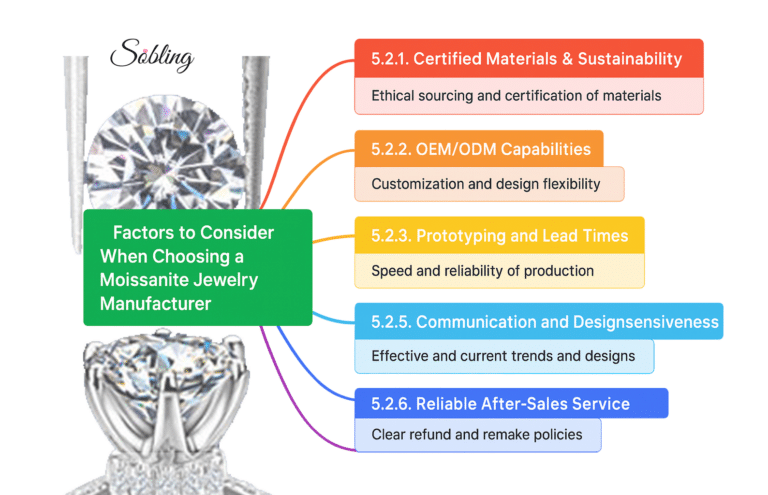
3. Why Choose Sobling as Your Moissanite Jewelry Partner?
3.1 Certified Materials & Sustainability
Sobling exclusively uses RJC-certified recycled silver and nickel-free alloys compliant with EU Reach. Every moissanite stone is lab-grown, batch-traceable, and GRA-certified, ensuring full transparency across the supply chain. Quality Certificates documents including SGS and TUV are provided with each qualifying order.
https://sobling.jewelry/wp-content/uploads/2023/04/Sobling-Team-Members.jpg
3.2 OEM/ODM Capabilities
With over 12 years of OEM/ODM experience, Sobling supports brands with All-in-One-Dienste: from CAD creation and 3D rendering to custom plating, engraving, packaging, and product storytelling. Whether you need minimalist bridal lines or bold Gen Z chains, Sobling delivers unique SKUs that reflect your brand DNA.
3.3 Prototyping and Lead Times
3.4 Communication and Responsiveness
3.5 Reliable After-Sales Service
A product issue after delivery can become a major brand problem if there’s no clear resolution path. That’s why Sobling has built a proactive, structured after-sales system tailored to the needs of B2B jewelry buyers. Every order is backed by a 30 Tage Rückgaberecht for surface defects or mis production, and a 360-day craftsmanship warranty covering structural issues such as stone loss, loose prongs, or misaligned settings.
This level of post-purchase support helps retailers and DTC brands resolve customer complaints quickly—without losing profit or brand trust. All claims are handled through a dedicated after-sales team with standardized documentation processes, including photo evidence and SKU verification. For international buyers, options include partial refunds, free remakes, or bulk order credits based on the nature and volume of the defect.
4. Case Study: From Local Brand to Moissanite Hero

4.1 Challenge:
- No existing products or manufacturing pipeline
- Need to launch within 60 days for a pre-holiday campaign
- Budget constraints and limited inventory capacity
- Target audience with high aesthetic and sustainability expectations
4.2 Sobling’s Solution:
- Developed a custom 12-SKU collection of moissanite jewelry including engagement rings, cuffs, and studs, using full OEM support
- Delivered 3D renders, naming conventions, and full product storytelling copy for every item
- Built a ready-to-upload Shopify product bundle, including mockups, copy, and specs
- Packaged using recyclable materials, paired with GRA-certified stones
4.3 Results in 90 Days:
- $68,000 USD in gross revenue
- 19.7% repeat customer rate within the first quarter
- Featured by BuzzFeed, and ranked on Etsy’s front page for “modern engagement ring”
- Expanded to 3 new countries through cross-border fulfillment
“Working with Sobling didn’t feel like outsourcing—it felt like building with an in-house team.”
— Brand Founder, California
Supported Moissanite Product Lines
- Engagement rings & bridal sets
- Tennis bracelets & eternity bands
- Moissanite Cuban link chains
- Minimalist studs & statement hoops
Global Client Base
Sobling currently serves 100+ jewelry brands across:
- Vereinigte Staaten
- Vereinigtes Königreich
- Australia
- Deutschland
- Singapore
- United Arab Emirates
Schlussfolgerung
Moissanite is more than just a diamond alternative—it’s a strategic material for building modern, ethical, and profitable jewelry brands. Its brilliance, durability, and lab-grown sustainability make it ideal for today’s value-driven consumers. From bridal sets to stacking rings, moissanite enables businesses to offer luxury without compromise, with greater flexibility in price, design, and sourcing.
For B2B buyers, choosing the right moissanite partner is crucial. Quality, speed, customization, and communication all matter—not just to your operations, but to your customers’ experiences. That’s why Sobling has built a full-service solution to support growing jewelry brands: low MOQ, private label expertise, recycled metals, trend-focused designs, and global fulfillment.
If you’re ready to launch or scale your moissanite jewelry line, Sobling is ready to be your design, development, and manufacturing partner. Let’s create jewelry that sparkles brighter—and builds stronger brands.
Useful links.
- Moissanite – Wikipedia
- Responsible Jewellery Council (RJC)
- Diamond vs. Moissanite: What are the differences?
- Nickel Directive – Wikipedia (EU REACH)
- SGS Jewelry Services – SGS USA
- GRA Gem Certification Lab – GRA
- What Is Moissanite? – American Gem Society
- Synthetic Moissanite: A New Diamond Substitute – GIA (Gems & Gemology)
- Moissanite vs Diamond – Ritani Blog
- Substances restricted under REACH – ECHA (EU Annex XVII)






